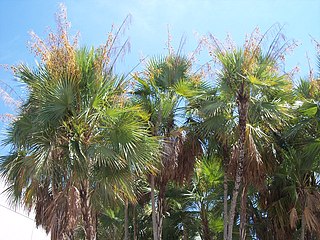
Acoelorrhaphe is a genus of palms with single species Acoelorrhaphe wrightii, known as the Paurotis palm, Everglades palm or Madeira palm in English and cubas, tique, and papta in Spanish.
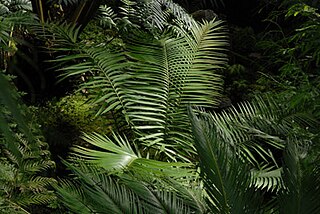
Ceratozamia is a genus of New World cycads in the family Zamiaceae. The genus contains 27 known currently living species and one or two fossil species. Most species are endemic to mountainous areas of Mexico, while few species extend into the mountains of Guatemala, Honduras and Belize. The genus name comes from the Greek ceras, meaning horn, which refers to the paired, spreading horny projections on the male and female sporophylls of all species.

Midgham Lock is a lock on the Kennet and Avon Canal, between Thatcham and Woolhampton, Berkshire, England.

Hammond's flycatcher is a flycatcher in the family Tyrannidae. This small insectivorous bird inhabits the coniferous and mixed forests of western North America. The name of this bird commemorates William Alexander Hammond who was the surgeon general of the US Army. Hammond collected bird specimens for Spencer Fullerton Baird.

The American gray flycatcher, or American grey flycatcher, or just gray flycatcher as it is known in North America, is a small, insectivorous passerine in the tyrant flycatcher family. It is common in the arid regions of western North America, especially the Great Basin. From sagebrush steppes to pinyon-juniper woodlands and ponderosa pine forests, this flycatcher forages for insects from shrubs or low tree branches.
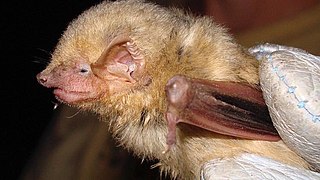
The western yellow bat is a species of vesper bat. It is found in Mexico and the southwestern United States. This species roosts in trees such as Populus fremontii, Platanus wrightii, and Quercus arizonica. If available, the western yellow bat will use the dead fronds that encircle palm trees as a roosting site.

Wright's skink, also known commonly as Wright's mabuya, is a species of lizard in the family Scincidae. The species is endemic to Seychelles. There are two recognized subspecies.

Colpothrinax wrightii, the palma barrigona, is a species of flowering plant in the family Arecaceae.
This is a list of plants which includes trees and other herbs, vines, climbers, lianas, shrubs, subshrubs that are native or endemic, found in Cuba.

Aloysia is a genus of flowering plants in the verbena family, Verbenaceae. They are known generally as beebrushes. They are native to the Americas, where they are distributed in temperate climates, as well as in subtropical and desert climates. The genus is named for Maria Luisa of Parma (1751-1819), wife of King Charles IV of Spain.
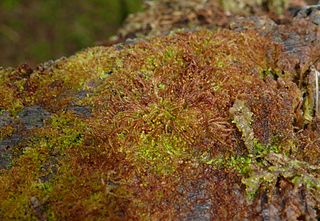
Nowellia is a genus of liverwort in the family Cephaloziaceae. It contains the following species :
Syzygium wrightii is a species of plant in the family Myrtaceae. It is endemic to Seychelles.

Eriogonum wrightii is a species of wild buckwheat known by the common names bastardsage and Wright's buckwheat. It is native to the Southwestern United States, California, and northwest Mexico, where it grows in many plant communities, such as chaparral, in rocky habitats from mountains to deserts.

Calycoseris wrightii, commonly known as white tackstem, is an annual spring wildflower, one of two species in the genus Calycoseris; the other species is C. parryi, the Yellow tack-stem. They are part of the sunflower family.
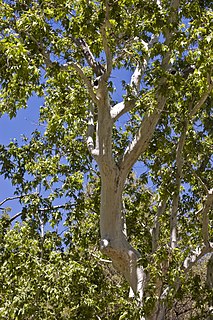
Platanus wrightii, the Arizona sycamore, is a sycamore tree native to Arizona and New Mexico with its range extending south into the Mexican states of Sonora, Chihuahua, and Sinaloa.
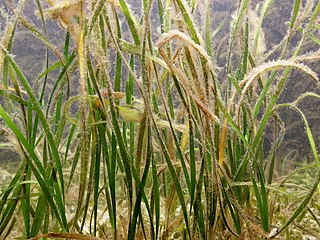
Halodule wrightii is an aquatic plant in the Cymodoceaceae family. It is referred to by the common names shoalweed or shoal grass, and is a plant species native to seacoasts of some of the warmer oceans of the world.
Halophila baillonis is a species of aquatic plant in the family Hydrocharitaceae. It is referred to by the common name clover grass. It is native to Brazil, Cayman Islands, Colombia, Costa Rica, Jamaica, Leeward Islands, Netherlands Antilles, Panama, Puerto Rico, Trinidad and Tobago, and Venezuela. It is listed on the IUCN Red List as "vulnerable" due to its naturally rare occurrence and fragmented populations.
Psylliodes luridipennis, commonly known as the Lundy cabbage flea beetle or the bronze Lundy cabbage flea beetle, is a species of flea beetle endemic to the island of Lundy, where it lives and feeds upon the endemic Lundy cabbage. Along with the true weevil Ceutorhynchus contractus var. pallipes and an undescribed race of flea beetle Psylliodes napi, it is known only from the Lundy cabbage. The species was first recorded by Thomas Vernon Wollaston in the 1840s, and was named by the Austrian entomologist Franz Kutschera in 1864.
Adenophyllum wrightii is a North American species of flowering plants in the daisy family known by the common names San Felipe dogweed, San Felipe dyssodia and Wright's dogweed. It is native to Mexico and the US States of Arizona and New Mexico. The species was long thought to be extinct in New Mexico, but live populations were rediscovered in the state in 1999.

Baccharis wrightii is a North American species of shrubs in the aster family known by the common name Wright's baccharis or false willow. It is native to northern Mexico and the southwestern and south-central United States.















